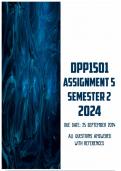, PLEASE USE THIS DOCUMENT AS A GUIDE TO ANSWER YOUR ASSIGNMENT
Please note that the author of this document will not responsibility for any plagiarizing you
commit.
Question 1
1.1. Discuss in only two paragraphs how the curriculum can be modified to accommodate
diverse learning styles.
To accommodate diverse learning styles, curriculum differentiation must be adopted. This involves
adapting content, teaching methods, and learning processes to align with learners' varied abilities,
interests, and readiness levels. For example, using Gardner’s multiple intelligences framework,
teachers can modify their approaches to appeal to linguistic, logical, spatial, musical, and kinesthetic
learners. Visual aids, hands-on activities, and auditory instructions ensure that learners engage with
material in ways that suit their individual strengths.
In addition to differentiated teaching strategies, curriculum modification also includes adjusting
assessments and learning environments. This ensures learners with different cognitive and
social-emotional needs are supported. Teachers can offer various forms of assessment like oral
presentations, group projects, or written tasks, and vary the complexity of activities based on
learners’ readiness. This approach ensures that all students, regardless of their learning style, can
access and benefit from the curriculum.
(Study Guide - Page: 69)
1.2. Discuss how the learning environment can be modified to accommodate learners with
disabilities, with reference to the following factors:
1.2.1. Accessible physical environment
Creating an accessible environment involves ensuring that classrooms are designed to accommodate
physical impairments. This includes installing ramps, widening doorways, and ensuring that
furniture is easily adjustable or accessible to accommodate wheelchairs and mobility aids .
1.2.2. Adaptive Technology
Assistive devices, such as screen readers, speech-to-text software, and magnifiers, are crucial in
supporting learners with disabilities. These technologies help bridge communication and learning
gaps, allowing learners to participate actively in the learning process.
1.2.3. Flexible Instructional material
Instructional materials must be adaptable to suit learners’ needs. For instance, offering text in
multiple formats (large print, braille, or audiobooks) ensures that learners with visual impairments
can access the content. Additionally, using multimedia resources helps engage learners with diverse
needs.




